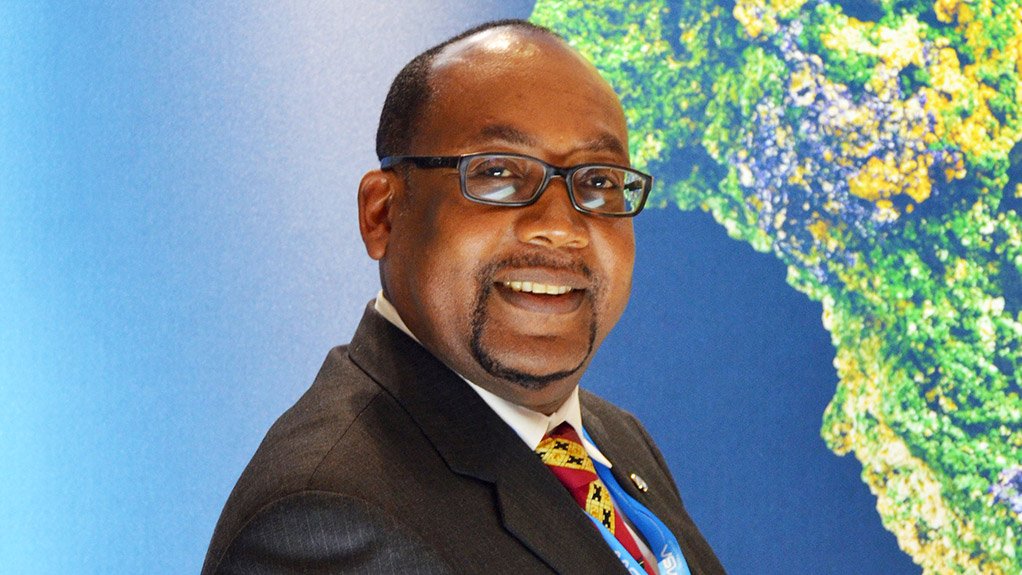Programme to position Ghanaian firms to gain greater share of mineral sector procurement





African Minerals Development Center (AMDC) coordinator Dr Kojo Busia
Ghana Lands and Natural Resources Minister John Amewu
Ghana Vice President Mahamudu Bawumia
Marking a significant point in Ghana’s quest to domesticate the provisions in the Africa Mining Vision (AMV) into its own Country Mining Vision (CMV), the Ghanaian government officially launched its National Suppliers Development Programme (NSDP) in 2 November 2017.
The NSDP builds and expands on existing policies, such as the local content policy, the One District One Factory Policy, the Strategic Anchor initiative and Ghana’s determination to develop clusters across the country. “It is also built on existing initiatives that mining companies have successfully rolled out at the levels of their mines,” stated Ghana Vice President Mahamudu Bawumia at the NSDP launch, in Accra.
The programme aims to build the capabilities of Ghanaian firms to secure a greater share of mineral sector procurement and, eventually, link with other productive sectors in the economy.
African Minerals Development Center (AMDC) coordinator Dr Kojo Busia stated that, while there is a plethora of global mining frameworks, the AMV is the only African-owned framework which undertakes minerals from an inclusive development approach rather than an extraction and rent maximisation approach.
Minister of Planning George Gyan-Baffour said like other countries, Ghana has internalised the AMV within its transformation agenda and is already working to bring a fundamental shift in its economic trajectory. “We have already implemented a number of landmark initiatives to change the business environment that has constrained the growth of the private sector and are investing in the capabilities of our youth so that they can grow up with a sense of purpose; especially with their sense of inclusion in the economic development process.”
As the second-largest gold producing country in Africa after South Africa and tenth-largest globally, Ghana is well placed to become a strong hub on the continent to supply the mining industry with various inputs and services, notes Gyan-Baffour. “The value of in-country spending by the mining industry is a low-hanging fruit, which can be a critical catalyst for the country’s industrial development.”
He added that Ghana is committed to break the silo within which the mining industry has traditionally operated. While this sector has some special needs, more important, it is sufficiently solid to provide sustainable business opportunities for the broader domestic private sector. Therefore, Ghana’s government wants to facilitate more investments, business partnerships and joint ventures and will “replace red tape with red carpet” to make business less costly and improve the competitiveness of its industries.
Ghana is aware that its industrial tissue needs to be supported and scaled up, so that it can supply the mining industry and provide it with high-quality and competitive inputs, stated Gyan-Baffour.
The NSDP comes at an opportune moment, as the government is stepping up all efforts to create a sustainable basis for a more industrialised and diversified economy, he stated.
Working to Industrialise Africa
Gyan-Baffour adds that numerous mineral-rich countries, such as Chile, Peru, Brazil, which had roughly comparable living standards like Ghana a few decades ago, managed to diversify their economic base by using their mineral sector as a launching pad for industrialisation and service provision.
It has become quite clear not only in Ghana but also across Africa that the continent’s immense natural resources have not been harnessed for Africa’s own development agenda, he expressed.
“We are all very aware that Africa holds a third of the world’s mineral reserves, including over half of platinum-group metals, diamonds and phosphates. And yet 60 years after independence, our economies continue to rely on the extraction and export of raw commodities.
This represents the lowest-value segment of mineral-based activities and value chains.”
AMDC’s Busia explained that, for example, the final value of processed products is typically worth 400 times more than the equivalent unit value by weight of the raw materials needed to produce these products. Meanwhile, the manufactured inputs and business services which feed into Africa’s extractive sectors – wiring, steel, information technology support, communications services and other activities – are largely sourced from abroad. “We see this in Africa’s trade patterns, where imports from the rest of the world are dominated by high-value industrial goods and exports are largely raw materials,” he notes.
Through all of this, Africa is helping to industrialise the world rather than industrialise itself, stressed Gyan-Baffour.
“Our copper, gold and oil are being transformed into batteries, jewellery and petroleum elsewhere and then sold back to us at exorbitant prices. It is time that we look at what mechanisms to put in place to end this destructive cycle.”
This situation is quite acute in Ghana in particular, Busia stated, where there is an acute lack of mineral-based transformation. As opposed to world-class mining supply and processing firms that have emerged in South Africa, Chile and other mineral producers, Ghana’s inputs and processing are undertaken and procured abroad.
Improving Value Chain Linkages
“Our initiative with the government of Ghana aims to identify the clearest opportunities in linking Ghanaian firms to the local and global mineral value chains. The first stage of this involves realizable high-value upstream linkages in industry and services. Indeed, for an average mining operation, around 60% of capital expenditure relates to procurement, and yet local spending can often apply only to low-value inputs such as catering or waste management,” stated Busia.
He noted that the joint work of the AMDC and the Bundesanstalt für Geowissenschaften und Rohstoffe or Germany’s Federal Institute for Geosciences and Natural Resources has identified a host of higher-value items that with the proper supporting environment can be produced locally. This potential fits well with the administration’s industrialisation agenda, highlighted by the One District One Factory initiative.
The AMDC’s work and consultations, thus far, point to the need for a comprehensive NSDP to build the right kinds of skills and capabilities among local firms to help them produce to the scale, quality and cost expected by firms. Importantly, the NSDP will bring together domestic suppliers of various mining and industrial inputs with the mining firms procuring from them. Thus, the NSDP will extend far beyond the mineral sector itself. Being owned jointly by the local private sector and government stakeholders, the NSDP will, thus, capture both the real on-the-ground needs of firms as well as draw on direct support from responsible government ministries.
Later stages of this initiative will aim to expand its scope to downstream gold and mineral beneficiation as well as to value-addition in the petrochemicals sector. This broadened approach will build on the NSDP and take advantage of lateral linkages and inputs across sectors.
Development Barriers
Ghana Lands and Natural Resources Minister John Amewu pointed out that, while mining’s investment attraction, fiscal and export revenues contribution have been significant, its value addition and other spill overs remain low.
He emphasised that while mining industry inputs demand represents real opportunities for Ghana’s industries and service providers, the supply side has not been able to live up to expectations and take advantage of these opportunities.
Ghana Chamber of Mines (CoM) president Kwame Addo-Kufuor highlighted that Ghana’s gold mining sector, the mainstay of its economy, accounted for 3% of global and 16% of Africa’s gold output in 2016. That same year, the sector accounted for 45.5% of foreign exchange earnings and 16% of direct domestic fiscal revenue mobilised by the Ghana Revenue Authority, making it the primary source of foreign exchange revenue and the highest tax-contributing sector respectively.
Although the mining sector has potential to contribute more to the development of Ghana’s economy through the value chain, there are some structural challenges which must be addressed, said Addo-Kufuor. “As the African Center for Economic Transformation (ACET) admits . . . these challenges have limited the sector’s ability to create strong and sustainable linkages both within the mining sector and, more broadly, with other industrial activities.”
The structural challenges cited by the ACET include an inefficient industrial base to supply the mining industry on a sustainable basis with competitive, timely and high-quality goods and services; the presence of a strong class of businessmen that currently act as intermediaries between importers and the mining industry and, therefore, crowd out nascent industries; the lack of political consensus around how to strengthen the linkages between mining and industrialisation; and the sticky business environment hurdles and administrative red tape that prevent linkages development.
“As steps are taken to address these problems, we assure you of our unalloyed support in positioning the mining sector as the catalyst for industrialisation,” Addo-Kufuor stated.
Suggesting a two-pronged approach to support the needs of the local industrial fabric, in terms of policy, Amewu empha-sised the need for support to remove bottlenecks that negatively impact on industrial development, including provision or facilitation of access to finance and competitive infrastructure, among others. From the industry side, he pointed out the need for capacity building and facilitated access to enable local companies to meet the requirements and exigencies of the mining industry and take advantage of opportunities.
However, Gyan-Baffour pointed out that It is neither simple nor easy to climb to higher segments of natural resource value chains – entrenched supplier networks, bargaining power of established firms and agreements favourable to multinational firms may limit the space for domestic value addition.
Existing Supplier Development
However, Amewu noted that mining sector supplier development programmes (SDPs) are not new in Ghana. At the micro level, numerous mines have promoted their own supplier development initiatives to acquire and maintain a social licence and/or enhance the positive impact of their operations on adjoining communities.
“At the meso level, the CoM has tried to encourage collaboration among the mines to, in their corporate social responsibility activities, drive SDPs which tended to be more for general services and the convenience of the industry players. At the macro level, the Minerals Commission, the CoM and the International Finance Corporation (IFC) have tried a partnership to enhance local content by creating a platform to develop local suppliers for the mining sector.”
Amewu said good examples of SDPs are gold producer Newmont Mining’s Ahafo business linkages programme and gold mining company Golden Star’s community benefit and value retention initiative, in Prestea, as well as its community youth apprentice skills, training and employable programme.
The NSDP will complement the chamber’s efforts to integrate the mineral sector into the nonmineral economy through the value chain. One such measure is the development of a portal on local content. The portal, which will provide information on strategic opportunities in the mining sector, launched on November 21. “Besides being a demonstration of our commitment to ensuring that local manufacturers and suppliers have more visibility in the value chain of the mining industry, it is also our expectation that the portal will generate interest in the manufacturing of imported mining inputs,” Amewu said.
However, he pointed out that the scope, strength and breadth of linkages expected of the mining industry’s SDP initiatives are beyond what was achieved in reality.
To deepen these linkages with other sectors, there is the need for a more national, strategic and coherent approach – the NSDP.
Developed using a multistakeholder approach to ensure integration of the mining sector into the other sectors of the economy, the NSDP is meant to build on the “excellent initiatives [at mine level] and scale them up”, so that local suppliers can have a larger market share, which will, in turn, allow them to grow their businesses, said Amewu.
Investigating the Value Chain
Addo-Kufuor explained that the mining industry’s impact is most pronounced in its value addition to the economy, which arises mainly through its interaction with the nonmineral economy.
In 2013, the Ghana CoM and International Council on Mining and Metals engaged specialised consultancy Steward Redqueen and the ACET to undertake a study on the life cycle contribution of the mining industry to Ghana’s economy.
The findings from the study suggest that the value added by Ghana’s mining sector, which is the monetary value of the direct, indirect and induced multipliers, to the economy in 2013 was equivalent to 3.2% of gross domestic product (GDP). More so, data by the CoM shows the physical input demand of goods (excluding diesel and electricity) by the producing member companies of the chamber averaged more than $1-billion in the last seven years.
“We estimate that the large-scale gold sector alone spends about $1.2-billion a year on operational expenditures in Ghana, equivalent to 3% of our country’s GDP,” Gyan-Baffour stated.
To make the most of the opportunities inherent in the value chain of the mining industry, the chamber collaborated with the IFC and Minerals Commission to identify some inputs that are used by the mining companies and that could be produced competitively in Ghana.
This culminated in the publication of the first procurement list for the mining sector in 2014 and the second edition in 2015.
“In all, the mining companies are expected to procure 19 items from in-country suppliers or manufacturers. According to the Minerals Commission, mining companies spent $394.8-million on procuring these items in 2016. Of this amount, $206.5-million represents the value of actual procurement from local manufacturers such as plastic pipe systems producer Interplast Ghana and lime products manufacturer Carmeuse Ghana,” stated Addo-Kufuor.
This, he added, equated to 52.3% of the total expenditure on the 19 items on the procurement list. “Thus, the remnant, $188.3-million, was spent on sourcing items directly or indirectly from foreign producers,” Addo-Kufuor noted, highlighting that the study suggests that, if the mining sector’s local procurement is increased by 25%, it would result in an additional 9 000 jobs.
“This will involve a framework coordinated at a government level high enough to wield the clout necessary to get and keep both the various arms of government . . . rolling along. Such a framework would be key to ensure that the programme encompasses all local-content-linked programmes and policies and involving mining and related industries.” In this regard, the new Minerals Commission CEO Kwaku Addai Antwi Boasiako is committed to promoting supply chain development so that Ghana may reap greater returns from its mineral wealth, an endeavour in which the Minerals Commission will be a key actor.
Pooling of Resources, Developing Skills
The NSDP is also meant to pull resources together and match overall demand from the mining industry and other sectors of the economy, which may need similar inputs, or whose products may harness the same industrial base.
“An example is the food sector. While suppliers can provide catering facilities to the mining industry, they could also do the same for the hospitality industry in general. There is big potential to use the mining sector as a launching pad for broader industrial and services development,” Amewu said.
The NSDP will ensure that capability challenges are addressed through tailor-made skills development programmes, starting with the education system and curriculum review, on-the-job and continuous training to upgrade the skills of our local workforce and ensure ready employability, even as certain functions become redundant, owing to technological advances.
Another factor key to success is investment in technology, research and development, and the creation of the necessary environment to stimulate creativity, innovation and entrepreneurship.
“One of the ways to sustain a world-class supply chain, based on experiences in countries like Chile, Brazil, Finland, Australia or Canada, is to systematically invest in and support systems of innovation, and connect research institutions and universities with the private sector to equip local businesses with the necessary skills, tools and sophistication to tap into higher value-added markets,” Amewu outlined, emphasising that Ghana wants to become a world-class regional hub.
Another fundamental element of success he points to is a strong and trusted partnership between the industry and local suppliers. The NSDP will ensure that there is a mechanism for regular consultations but, more importantly, for joint initiatives and strategic development, so that the mining sector can truly benefit Ghana’s economy and people.
Comments
Press Office
Announcements
What's On
Subscribe to improve your user experience...
Option 1 (equivalent of R125 a month):
Receive a weekly copy of Creamer Media's Engineering News & Mining Weekly magazine
(print copy for those in South Africa and e-magazine for those outside of South Africa)
Receive daily email newsletters
Access to full search results
Access archive of magazine back copies
Access to Projects in Progress
Access to ONE Research Report of your choice in PDF format
Option 2 (equivalent of R375 a month):
All benefits from Option 1
PLUS
Access to Creamer Media's Research Channel Africa for ALL Research Reports, in PDF format, on various industrial and mining sectors
including Electricity; Water; Energy Transition; Hydrogen; Roads, Rail and Ports; Coal; Gold; Platinum; Battery Metals; etc.
Already a subscriber?
Forgotten your password?
Receive weekly copy of Creamer Media's Engineering News & Mining Weekly magazine (print copy for those in South Africa and e-magazine for those outside of South Africa)
➕
Recieve daily email newsletters
➕
Access to full search results
➕
Access archive of magazine back copies
➕
Access to Projects in Progress
➕
Access to ONE Research Report of your choice in PDF format
RESEARCH CHANNEL AFRICA
R4500 (equivalent of R375 a month)
SUBSCRIBEAll benefits from Option 1
➕
Access to Creamer Media's Research Channel Africa for ALL Research Reports on various industrial and mining sectors, in PDF format, including on:
Electricity
➕
Water
➕
Energy Transition
➕
Hydrogen
➕
Roads, Rail and Ports
➕
Coal
➕
Gold
➕
Platinum
➕
Battery Metals
➕
etc.
Receive all benefits from Option 1 or Option 2 delivered to numerous people at your company
➕
Multiple User names and Passwords for simultaneous log-ins
➕
Intranet integration access to all in your organisation






















